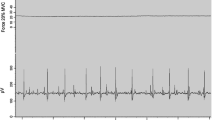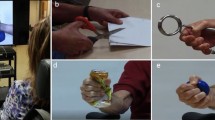Abstract
We compared motor unit synchronization and firing rate variability within and across synergistic hand muscles during a pinching task following short-term light-load training to improve force steadiness in older adults. A total of 183 motor unit pairs before training and 158 motor unit pairs after training were recorded with intramuscular fine-wire electrodes within and across the first dorsal interosseous (FDI) and adductor pollicis (AdP) muscles during a pinch task performed by ten older adults before and after a 4-week short-term light-load training program. Nine younger adults performed the same experimental sessions 4 weeks apart with no training intervention. Two-minute sustained contractions of 2, 4, 8, and 12% maximal voluntary contraction (MVC) were performed with the non-dominant hand. The coefficient of variation (CV) of force was greater in older than in younger adults and was lower at the 2 and 4% MVC levels in both the finger (0.12 ± 0.01 vs. 0.08 ± 0.01, and 0.08 ± 0.01 vs. 0.05 ± 0.01, respectively) and thumb (0.11 ± 0.01 vs. 0.08 ± 0.01, and 0.09 ± 0.01 vs. 0.05 ± 0.01, respectively) compared to higher force levels following training in the older adults. There were no changes in CIS or k’-1 values following training. Motor unit firing rate variability significantly decreased at low force levels in the FDI muscle and also tended to decrease with training in the AdP muscle (p = 0.06). No changes occurred in the younger control group. These findings are the first to show that motor unit synchronization does not change during light-load training. Thus, it is likely that force steadiness in older adults improves by reducing motor unit firing variability rather than by changing motor unit synchronization.






Similar content being viewed by others
References
Christakos CN (1982) A study of the muscle force waveform using a population stochastic model of skeletal muscle. Biol Cybern 44:91–106
Dietz V, Bischofberger E, Wita C, Freund HJ (1976) Correlation between the discharges of two simultaneously recorded motor units and physiological tremor. Electroencephalagr Clin Neurophysiol 40:97–105
Eisen A, Siejka S, Schulzer M, Calne D (1991) Age-dependent decline in motor evoked potential (MEP) amplitude: with a comment on changes in Parkinson’s disease. Electroencephalogr Clin Neurophysiol 81:209–215
Ellaway PH (1978) Cumulative sum technique and its application to the analysis of peristimulus time histograms. Electroencephalogr Clin Neurophysiol 45:302–304
Erimaki S, Christakos CN (1999) Occurrence of widespread motor-unit firing correlations in muscle contractions: their role in the generation of tremor and time-varying voluntary force. J Neurophysiol 82:2839–2846
Evans WJ, Starr A (1994) Electroencephalography and evoked potentials in the elderly. In: Albert ML, Knoefel JE (eds) Clinical neurology of aging. Oxford University Press, New York, pp 235–265
Galganski ME, Fuglevand AJ, Enoka RM (1993) Reduced control of motor output in a human hand muscle of elderly subjects during submaximal contractions. J Neurophysiol 69:2108–2115
Gardner E (1940) Decrease in human neurones with age. Anat Rec 77:529–536
Garland SJ, Griffin L (1999) Double discharges: statistical anomaly or functional entity? Can J Appl Physiol 24:113–130
Griffin L, Garland SJ, Ivanova T (1998) Discharge patterns in human motor units during fatiguing arm movements. J Appl Physiol 85:1684–1692
Hockensmith GB, Lowell SY, Fuglevand AJ (2005) Common input across motor nuclei mediating precision grip in humans. J Neurosci 25:4560–4564
Huesler EJ, Maier MA, Hepp-Reymond MC (2000) EMG activation patterns during force production in precision grip. III. Synchronization of single motor units. Exp Brain Res 134:441–445
Kamen G, Greenstein SS, De Luca CJ (1992) Lateral dominance and motor unit firing behaviour. Brain Res 576:165–167
Keen DA, Yue G, Enoka RM (1994) Training related enhancement in the control of motor output in elderly humans. J Appl Physiol 77:2648–2658
Kidgell DJ, Sale MV, Semmler JG (2006) Motor unit synchronization measured by cross-correlation is not influenced by short-term strength training of a hand muscle. Exp Brain Res 175:745–753
Kirkwood PA, Sears TA (1978) The synaptic connections to intercostals motoneurons as revealed by the average common excitation potential. J Physiol 275:103–134
Kornatz KW, Christou EA, Enoka RM (2005) Practice reduces motor unit discharge variability in a hand muscle and improves manual dexterity in old adults. J Appl Phyisol 98:2072–2080 2005
Laidlaw DH, Bilodeau M, Enoka RM (2000) Steadiness is reduced and motor unit discharge is more variable in old adults. Muscle Nerve 23:600–612
Logigian EL, Wierzbicka MM, Bruyninckx F, Wiegner AW, Shahahi BT, Young RR (1988) Motor unit synchronization in physiologic, enhanced physiologic, and voluntary tremor in man. Ann Neurol 23:242–250
Mathews PB (1996) Relationship of firing intervals of human motor units to the trajectory of post-spike after-hyperpolarization and synaptic noise. J Physiol (Lond) 492:597–628
Mathews PB (1999) Properties of human motoneurones and their synaptic noise deduced from motor unit recordings with the aid of computer modelling. J Physiol (Paris) 93:135–145
Moritz C, Barry B, Pascoe MA, Enoka RM (2005) Discharge rate variability influences the variation in force fluctuations across the working range of a hand muscle. J Neurophysiol 93:2449–2459
Nordstrom MA, Fuglevand AJ, Enoka RM (1992) Estimating the strength of common input to human motoneurons from the cross-correlogram. J Physiol 453:547–574
Ranganathan VK, Siemionow V, Sahgal V, Yue GH (2001) Effects of aging on hand function. J Am Geriatr Soc 49:1478–1484
Schmied A, Vedel JP, Pagni S (1994) Human spinal lateralization assessed from motoneuron synchronization: dependence on handedness and motor unit type. J Physiol 480:369–387
Sears TA, Stagg D (1976) Short-term synchronization of intercostals motoneurone activity. J Physiol 263:357–381
Semmler JG, Nordstrom MA (1995) Influence of handedness on motor unit discharge properties and force tremor. Exp Brain Res 104:115–125
Semmler JG, Nordstrom MA (1998) Motor unit discharge and force tremor in skill and strength-trained individuals. Exp Brain Res 119:27–38
Semmler JG, Steege JW, Kornatz KW, Enoka RM (2000) Motor unit synchronization is not responsible for larger motor unit forces in old adults. J Neurophysiol 84:358–366
Semmler JG, Sale MV, Meyer FG, Nordstrom MA (2004) Motor-unit coherence and its relation with synchrony are influenced by training. J Neurophysiol 92:3320–3331
Spirduso WW, Eakin T, Francis K, Stanford C (2005) Quantification of manual force control and tremor. J Motor Behav 37:197–210
Tracy BL, Maluf KS, Stephenson JL, Hunter SK, Enoka RM (2005) Variability of motor unit discharge and force fluctuations across a range of muscle forces in older adults. Muscle Nerve 32:533–540
Vaillancourt DE, Larsson L, Newell KM (2003) Effects of aging on force variability, single motor unit discharge patterns, and the structure of 10, 20, and 40 Hz EMG activity. Neurobiol Aging 24:25–35
Weigner AW, Wierzbick MM (1987) A method for assessing significance of peaks in cross-correlation histograms. J Neurosci Meth 22:125–131
Yao W, Fuglevand AJ, Enoka RM (2000) Motor-unit synchronization increases EMG amplitude and decreases force steadiness of simulated contractions. J Neurophysiol 83:441–452
Acknowledgment
This study was funded by NIH grant 1 R03 AR52883-01, L. Griffin (PI).
Author information
Authors and Affiliations
Corresponding author
Rights and permissions
About this article
Cite this article
Griffin, L., Painter, P.E., Wadhwa, A. et al. Motor unit firing variability and synchronization during short-term light-load training in older adults. Exp Brain Res 197, 337–345 (2009). https://doi.org/10.1007/s00221-009-1920-4
Received:
Accepted:
Published:
Issue Date:
DOI: https://doi.org/10.1007/s00221-009-1920-4




